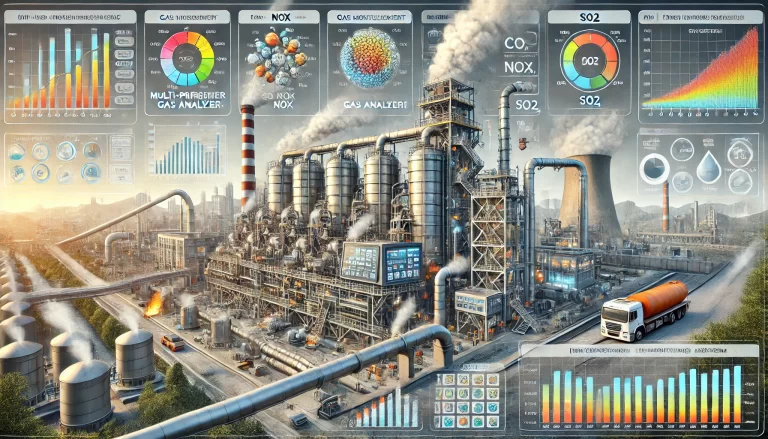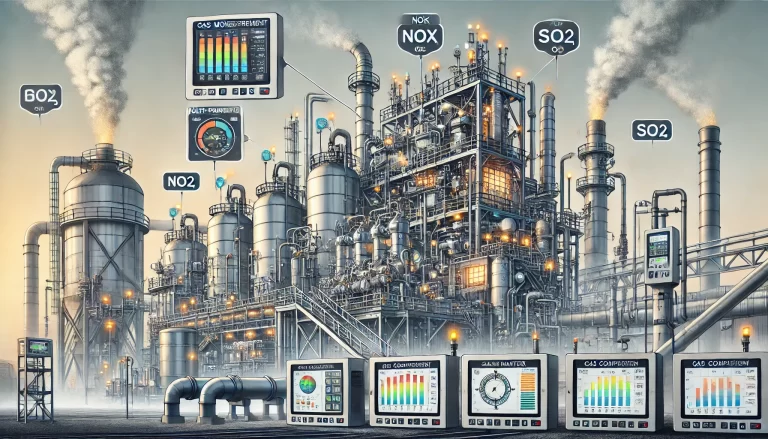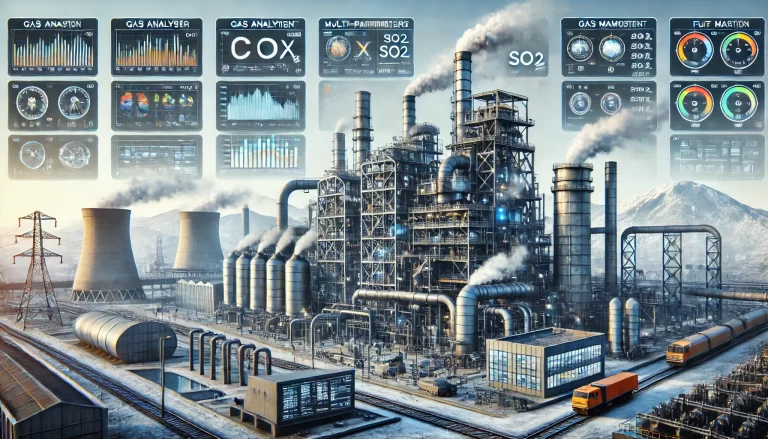Introduction
Coking flue gas is an important industrial by-product generated in factories where coal undergoes high-temperature pyrolysis. It is particularly common in industries such as steelmaking, coke production, fertilizer manufacturing, and energy production. The coking process involves heating coal in an oxygen-deficient environment, causing it to decompose thermally and release gases. These gases include valuable combustible components as well as hazardous pollutants. Due to its complex composition, coking flue gas poses environmental risks and safety concerns, necessitating precise measurement and monitoring.
Accurate and efficient measurement of coking flue gas is crucial not only for pollution control but also for enhancing production efficiency and ensuring compliance with environmental regulations. This article explores the composition of coking flue gas, various measurement techniques, key challenges, and its significance in industrial applications.

Composition and Characteristics of Coking Flue Gas
The composition of coking flue gas varies depending on factors such as coal type, furnace conditions, and combustion efficiency. However, it typically includes the following key components:
1. Carbon Monoxide (CO)
A major component of coking flue gas, carbon monoxide is highly reactive and participates in combustion reactions to form carbon dioxide (CO₂).
Excessive concentrations of CO pose environmental hazards and can lead to explosion risks in industrial settings.
2. Nitrogen Oxides (NOₓ)
NOₓ gases, primarily nitric oxide (NO) and nitrogen dioxide (NO₂), are by-products of high-temperature combustion in the presence of oxygen.
These pollutants contribute to acid rain, smog formation, and respiratory health problems.
3. Sulfur Dioxide (SO₂)
Generated when sulfur in coal reacts with oxygen during combustion.
SO₂ is a major cause of air pollution and acid rain, significantly impacting ecosystems and human health.
4. Particulate Matter (PM)
Solid particles and aerosols, including unburned carbon, ash, and hazardous substances, are present in coking flue gas.
High concentrations can reduce air quality and pose respiratory health risks.
5. Volatile Organic Compounds (VOCs)
Compounds such as benzene, toluene, and xylene are common in coking flue gas.
These pollutants are toxic and contribute to the formation of ground-level ozone and smog.
6. Water Vapor (H₂O)
Significant amounts of water vapor result from the evaporation of moisture present in coal.
The presence of water vapor affects gas measurements by altering temperature and humidity levels.
Due to this complex mixture of gases and pollutants, accurate real-time monitoring is essential to ensure environmental compliance and safe industrial operations.

Measurement Techniques for Coking Flue Gas
To effectively monitor and manage coking flue gas emissions, various measurement technologies are employed. These techniques must provide accurate, real-time data while operating reliably in harsh industrial conditions.
1. Multi-Parameter Gas Analyzers
These analyzers can detect and measure multiple gas components simultaneously, including CO, CO₂, NOₓ, and SO₂.
Common methods used in these analyzers include Non-Dispersive Infrared (NDIR) spectroscopy and Tunable Diode Laser Absorption Spectroscopy (TDLAS).
2. Differential Pressure Flow Meters
These instruments measure the pressure difference within a pipeline to calculate gas flow rates.
They are widely used for monitoring the volume and velocity of coking flue gas emissions, which is essential for energy management and pollution control.
3. Temperature and Humidity Sensors
Monitoring the temperature and humidity of flue gas helps in understanding combustion efficiency and pollutant dispersion.
These sensors ensure that gas measurement systems compensate for variations in environmental conditions.
4. Automated Monitoring Systems
Modern coking plants integrate automatic monitoring systems that collect real-time data on gas composition, flow rates, and temperature.
These systems enhance regulatory compliance by providing continuous emissions tracking and alarm mechanisms for safety control.
5. Particulate Matter (PM) Measurement
Laser scattering, gravimetric methods, and electrical techniques are used to monitor PM concentrations in flue gas.
Continuous PM monitoring helps reduce airborne pollution and improve emission control strategies.
6. Level Sensors for Dust and Gas Scrubbing Equipment
Various level sensors, including vibrating rod level switches, rotary paddle level indicators, and radio-frequency admittance sensors, are employed in gas scrubbing systems to monitor particulate accumulation and ensure optimal functioning.
Challenges in Coking Flue Gas Measurement
Despite advancements in measurement technologies, several challenges persist in accurately monitoring coking flue gas:
1. Complex Gas Composition
The variability in coal types and furnace operating conditions causes fluctuations in gas concentrations.
Achieving accurate, real-time monitoring of all components is technically demanding.
2. High-Temperature and High-Humidity Conditions
Coking flue gas often contains high levels of moisture and operates at elevated temperatures, which can degrade sensor performance over time.
Measurement systems must be robust and resistant to corrosion, heat, and humidity.
3. Environmental Interference
External factors such as temperature changes, pressure variations, and dust accumulation can impact measurement accuracy.
Calibration and compensation mechanisms are essential for minimizing measurement errors.

Industrial Applications and Benefits of Coking Flue Gas Measurement
Accurate measurement of coking flue gas is critical for environmental protection, industrial safety, and operational efficiency. Key benefits include:
1. Environmental Compliance and Emission Control
Real-time gas monitoring ensures compliance with environmental regulations by tracking pollutant concentrations.
Helps industries reduce greenhouse gas emissions and air pollution.
2. Industrial Safety Enhancement
Continuous monitoring of CO and other combustible gases reduces explosion risks.
Timely detection of gas leaks prevents hazardous incidents.
3. Improved Energy Efficiency
Optimized gas utilization in coke ovens enhances energy efficiency and reduces fuel waste.
Monitoring systems allow for process adjustments that lead to cost savings and sustainability improvements.
4. Regulatory Compliance and Cost Reduction
Stringent environmental policies require industries to maintain accurate emissions records.
Effective monitoring minimizes the risk of regulatory fines and legal penalties.

Conclusion
Coking flue gas measurement plays a vital role in pollution control, industrial safety, and energy optimization. With continuous advancements in gas analysis technologies, industries can achieve higher levels of accuracy, efficiency, and regulatory compliance. The future of coking gas measurement will likely incorporate more AI-driven predictive analytics and smart monitoring systems, paving the way for sustainable and environmentally responsible industrial operations.
